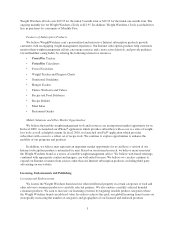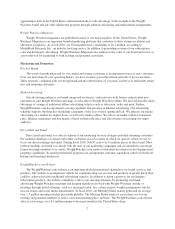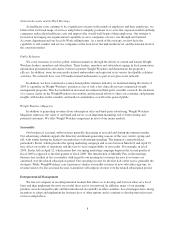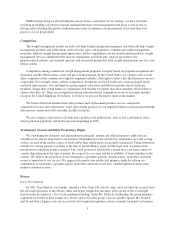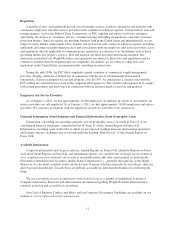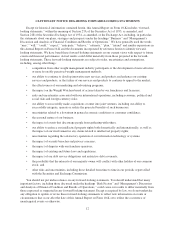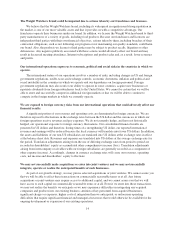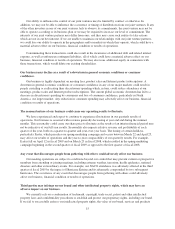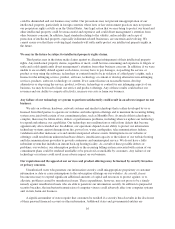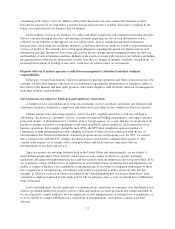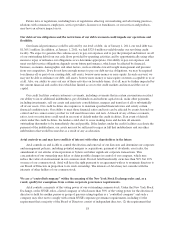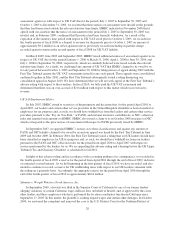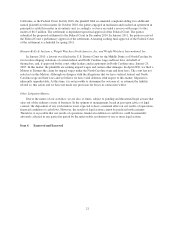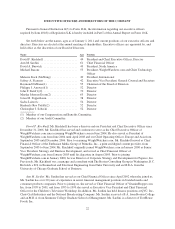WeightWatchers 2010 Annual Report Download - page 31
Download and view the complete annual report
Please find page 31 of the 2010 WeightWatchers annual report below. You can navigate through the pages in the report by either clicking on the pages listed below, or by using the keyword search tool below to find specific information within the annual report.Our ability to influence the control of our joint ventures may be limited by contract or otherwise. I
n
addition, we may not be able to influence the occurrence or timing of distributions from our joint ventures. If an
y
o
f the other investors in one of our joint ventures fails to observe its commitments, the joint venture may not b
e
able to operate according to its business plan or we may be required to increase our level of commitment. Th
e
interests of our joint venture partners may differ from ours, and they may cause such entities to take actions
which are not in our best interest. If we are unable to maintain our relationships with our joint venture partners
,
we could lose our ability to operate in the geographies and/or markets in which they operate, which could have
a
material adverse effect on our business, financial condition or results of o
p
erations.
Consummating these transactions could also result in the incurrence of additional debt and related interes
t
expense, as well as unforeseen contingent liabilities, all of which could have a material adverse effect on our
business, financial condition or results of operations. We may also issue additional equity in connection wit
h
these transactions, which would dilute our existing shareholders.
O
ur bus
i
ness may decl
i
ne as a result o
f
a downturn
i
n general econom
i
c cond
i
t
i
ons or consume
r
con
fi
dence
.
Our business is highly dependent on meeting fees, product sales and Internet product subscriptions. A
downturn in general economic conditions or consumer confidence in any of our major markets could result in
p
eople curtailing or reallocating their discretionary spending which, in turn, could reduce attendance at ou
r
meetings, product sales and Internet product subscriptions. The current global economic downturn has led to
a
decrease in discretionary spending by consumers and loss of consumer confidence, particularly in Nort
h
America, our largest market. Any reduction in consumer spending may adversely affect our business, financial
condition or results of o
p
erations.
The seasonal nature o
f
our bus
i
ness could cause our operat
i
ng results to
f
luctuate
.
We have experienced and expect to continue to experience fluctuations in our quarterly results of
o
perations. Our business is seasonal with revenues generally decreasing at year end and during the summe
r
months. This seasonality could cause our share price to fluctuate as the results of an interim financial period ma
y
not be indicative of our full year results. Seasonality also impacts relative revenue and profitability of eac
h
quarter of the year, both on a quarter-to-quarter and year-over-year basis. The timing of certain holidays
,
p
articularly Easter, which precedes our spring marketing campaign and occurs between March 22 and April 2
5,
may affect our results of operations and the year-to-year comparability of our quarterly results. For example
,
Easter fell on April 12 in fiscal 2009 and on March 23 in fiscal 2008, which resulted in the spring marketing
campaign beginning in the second quarter of fiscal 2009 as opposed to the first quarter of fiscal 2008
.
Any event that d
i
scourages people
f
rom gather
i
ng w
i
th others could adversely a
ff
ect our bus
i
ness
.
Our meeting operations are subject to conditions beyond our control that may prevent current or prospectiv
e
members from attending or joining meetings, including extreme weather, terrorism, health epidemics, national
disasters and other extraordinary events. For example, our NACO attendance was adversely affected in the third
quarter of fiscal 200
5
by the impact of Hurricane Katrina and its aftermath, compounded by two subsequent
hurricanes. The occurrence of any event that discourages people from gathering with others could adversely
affect our business, financial condition or results of o
p
erations
.
Th
i
rd part
i
es may
i
n
f
r
i
nge on our brand and other
i
ntellectual property r
i
ghts, wh
i
ch may have a
n
adverse
i
m
p
act on our bus
i
ness
.
We currently rely on a combination of trademark, copyright, trade secret, patent and other intellectual
p
roperty laws and confidentiality procedures to establish and protect our proprietary rights, including our brand.
If we fail to successfully enforce our intellectual property rights, the value of our brand, services and products
1
5


